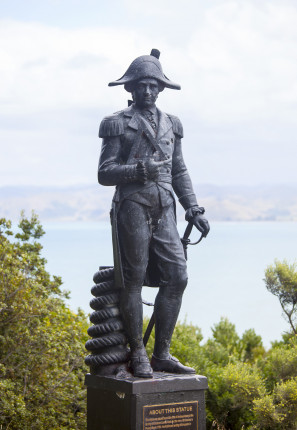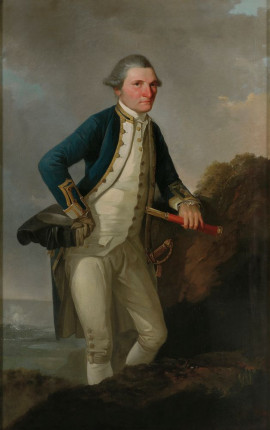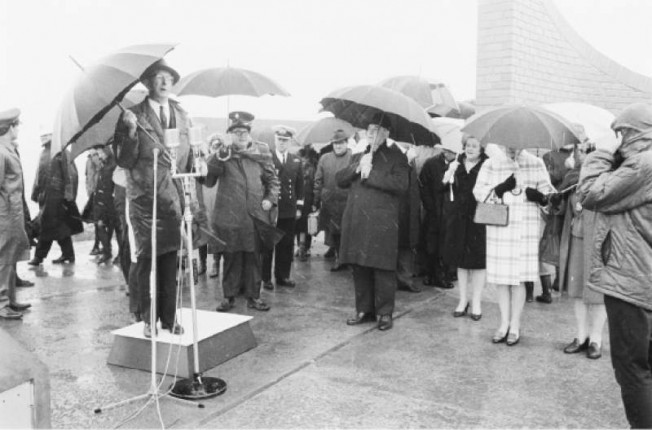The ‘Crook Cook’ – the story of the statue
Gisborne’s ‘Crook Cook’ – the story behind the statue
The statue of James Cook, often refered to as ‘The Crook Cook’, was installed on Titirangi (Kaiti Hill) for the ‘Cook Bicentenary’ in Gisborne in October 1969.
It is one of three bronze copies of a marble statue that was made for the Captain Cook Brewery in Newmarket, Auckland in the early 1880s.
Because the face is not readily recognisable as a likeness of Cook, and the uniform is incorrect, it was thought for many years to not be a statue of Cook at all. A plaque was installed in October 1998 with the words ‘‘Who is he? We have no idea?” based on this erroneous conclusion.
Research into the history of the statue over the last ten years, and in particular a thorough research project undertaken by writer Christopher Paxton (published 2012), confirms that it is a statue of Captain James Cook. Despite this research being reported extensively in The Gisborne Herald, it remains a common misconception, particularly as the 1998 plaque still accompanies the statue and continues to sow confusion over the identity of the subject.
Does it look like Cook?
The statue is a likeness of Cook that is possibly based on a head-and-shoulders engraving by English artist James Basire, 1777, which was in turn based on Hodge’s portrait of Cook, 1775-6. (1)
The face of the statue does not closely resemble today’s well-known portraits or sculptures of Cook. However, as only a small number of portraits were drawn from life, many ‘likenesses’ of Cook do not resemble each other. The Cook we recognise today is something of a stereotype, based on a proliferation of representations by generations of artist, engravers and sculptors. (2) Of all the portraits the statue’s face appears to have the closest likeness to the Basire portrait.
The Basire portrait was used as the frontispiece of the account of Cook’s second voyage and so it is this engraving, rather than the oil painting by Hodges, which became the earliest image of Cook available to the public, and would have been widely-recognised as a depiction of Cook in the late 1800s. (3)
Interestingly, there were at least two reproductions of the Nathaniel Dance portrait by Auckland artist RH Bartlett that would have been publicly accessible in Auckland not long after the statue was installed. One was was displayed in the offices of the Auckland Savings Bank, (and is now on display in Tairāwhiti Museum) and another was on display at the Auckland Free Public Library when it opened in 1887 (current whereabouts unknown).
Who made the original sculpture?
Samuel Jagger (the owner of Captain Cook Brewery in Auckland) visited an exhibition in Sydney in 1882 and commissioned the statue based on “the best known portrait [of Captain Cook] in existence” that was on display in the exhibition. While the portrait on display in this exhibition has not been confirmed, it is thought to be the Basire engraving. (4)
The sculptor of the original marble statue is unknown. It was possibly carved in Sydney by Achille Simonetti (1838-1900), a professionally trained Italian-Australian sculptor. It may also have been carved overseas and imported in to Sydney. (5)
An article in the Auckland Star (3.12.1884) states it was sculpted by a ‘Mr Wilson’ but no sculptor of this name has been found in NZ, Australia or the UK, and as there are a number of mistakes in the article it may be a false lead.
In 1884 the statue was shipped to New Zealand and mounted on the roof above the main entrance to the new brick brewery building in Auckland, built by Baildon and Stephenson.
It was described at the time as “an excellent and well-finished statue”, “one of the handsomest specimens of graceful statuary to be found in the colonies” and “a very striking likeness”. (4) The words “Captn Cook” inscribed in the base of the statue confirm the identity of the subject.
Captain Cook Brewery was one of ten breweries amalgamated to form NZ Breweries Ltd and the company changed its name to Lion Breweries in 1977. The original sculpture is now held in the collections of The University of Auckland.
Is the uniform correct?
No. Cook is not wearing the uniform of a British naval officer, nor does his uniform resemble that of any other European naval uniforms.(6) The uniform has been described as ‘Italian’ in style.
The sculptor has him wearing a coat with collar down and buttoned across the chest – a late-eighteenth/early nineteenth century style, dating from after Cook’s death. He wears a Lieutenant’s coat, with Captain’s epaulettes.
On his head he wears a Captain’s bicorne (a style which replaced the tricorne in the 1790s) worn in the ‘athwart’ (side-to-side) style as it would have commonly been worn in the 1790s. Cook’s uniform would have included a tricorne hat and an open coat with a low collar and no epaulettes (as shown in the Webber portrait).
The artist may not have been aware of what Cook’s uniform would have looked like and likely used the nineteenth century uniform references that would have been familiar to him when he was carving the statue in the 1880s.
The 1969 bronze casts
A committee of Gisborne’s local body Chairmen was appointed in 1966 to oversee the selection and the location of memorials for the ‘Cook Bicentenary’. This committee arranged the purchase of a bronze casting from the New Zealand Breweries statue.
Three 1 ½ tonne bronze castings were made by DMS Foundry in Penrose, Auckland. One cast came to Gisborne, one went to James Cook High School in Manurewa and one to the Brewery Headquarters in Papatoetoe (where they both still stand).
DMS (Designers Moulders Sculptors) Foundry was established by Ronald Ranby (1904 – 1983) in 1956. Ranby was one of New Zealand’s most experienced sculptors at the time. He studied at Canterbury College School of Art under Frederick George Gurnsey and was a former studio assistant of Richard Goss, a major contributor to NZ sculpture between the wars.
The cost of casting, delivery and installation of the statue was $23,515.63. $4000 in public donations were received, including $1000 from NZ Brewery, half the cost of the statue.
In August 1969 James Barry, designer of the original plaque, wrote to Mayor Harry Barker saying the statue was wrong, and a better option would be to copy Thomas Brock’s statue (in London) of Cook. He was concerned the outfit was of an Italian Admiral.
Barker replied “Matters are so far advanced now that it is not possible to make any change. The position is complicated by the fact that NZ Breweries have agreed to meet half the cost. I do not doubt that when the statue is erected it will cause a certain amount of comment, the most we can hope for is that it will be a nine days wonder and that attention will be attracted more to the plaque itself and the monument than to the statue. The position is regrettable, apparently, unavoidable.”
The statue was unveiled by Governor General Sir Arthur Porritt in October 1969.
- Eloise Wallace, Director Tairāwhiti Museum
Further resources
A Likeness of Captain Cook? By Christopher Paxton, 2012 Originally published in New Zealand Legacy, the journal of the New Zealand Federation of Historical Societies. vol. 25, no. 3 (2013).
The Gisborne Herald Crook Cook timeline
Gisborne Herald Article, 2016 by Kayla Dalrymple
Listen to a recording of the Unveiling of the Cook statue on Kaiti Hill, Gisborne, held in the collection of Ngā Taonga Sound and Vision online. It plays approx 37 minutes in to the tape.
(1) The portrait in the exhibition which this statue is reputedly based on is still something of a mystery. See Christopher Paxton’s detailed observations and conclusions A Likeness of Captain Cook?, 2012
(2) and (3) National Museum Australia ‘Depictions of Captain James Cook
(4) Auckland Star Volume XXVI Issue 4528, 3 December 1994
(5) See summary of research provided by Edna Carson (Lion Breweries) and Ken Scarlett. Christopher Paxton A Likeness of Captain Cook?, 2012
(6) See Christopher Paxton for more detailed analysis of uniform A Likeness of Captain Cook?, 2012














